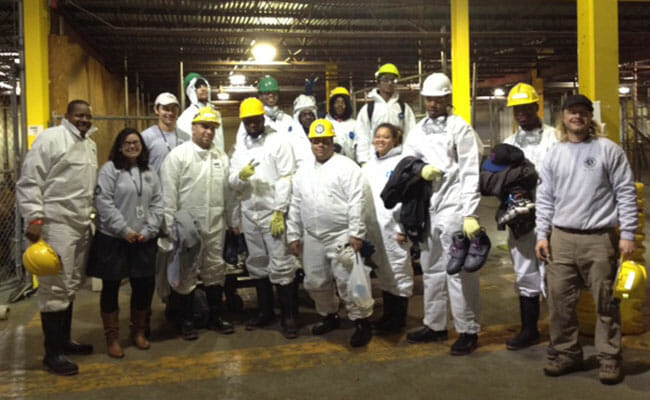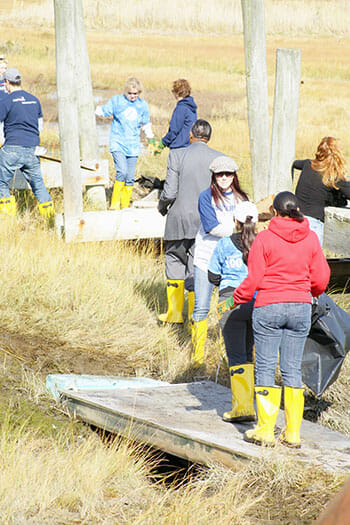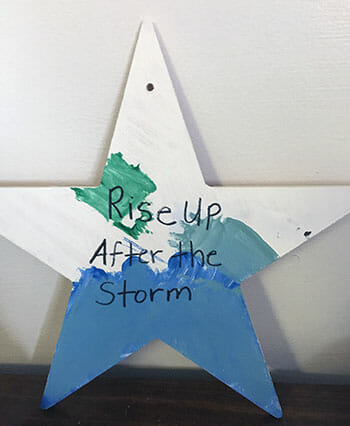The Critical Role of Volunteers in Hurricane-Affected Communities

On Oct. 29, 2012, vast numbers of Long Island communities suffered overwhelming devastation as Superstorm Sandy truly brought the region to its knees. But out of that loss and despair came hope, as neighbors helped neighbors, and local organizations and volunteers stepped up to assist with the immediate response and to embark on the long road to recovery.
“If I had to pick my one word for the response, it would be community, how we unselfishly came together to help those in deep distress by pooling our strength and sharing the work and the responsibility,” said Diana O’Neill, executive director of the Long Island Volunteer Center, a Points of Light affiliate. “I have never witnessed or experienced anything like it — manifestations of true camaraderie and genuine human-kindness. It was the greatest privilege of my life to have a front row seat at our Volunteer Recovery Center, seeing the myriad organizations easing human suffering together on such a grand scale.”
As other communities face the aftermath of devastating storms, Diana shares her reflections on recovery and how volunteers can help in disaster-affected areas today.
How did Superstorm Sandy impact your organization?

Being involved in such essential disaster work was made possible by public/private partnerships which gave us a roof over our heads, lift to our programming, and full logistics support for disaster groups. We were an all-volunteer organization and did not have in-house disaster expertise. As part of the Long Island Voluntary Organizations Active in Disaster, the Long Island Volunteer Center opened the Volunteer Recovery Center in donated former office and warehouse space of Sleepy’s in 2012 and operated it through 2013 with the assistance of AmeriCorps St. Louis ERT and the Points of Light network disaster response team, which supported us with help from Boston Cares, North Dallas Volunteer Center, Volunteer Fairfax, Howard County Volunteer Center, Western New York Volunteer Center, Hands On Atlanta, and New York Cares. Also funding via American Red Cross, Major League Baseball Players Trust, Bessemer Trust, GE Foundation, The Nunn Family Foundation, and Allstate Foundation was secured through Points of Light. We are forever in their debt. I cannot speak more highly of the dedication and professionalism of the LIVC disaster team, which was assembled along the way and who led by example — such gifted professionals paved the way for a coordinated response.
What role did volunteers play in supporting Long Island and your organization after Superstorm Sandy, both in the immediate response and long-term recovery?
In the volunteer industry, being invited to the human condition is a gift, the most noble of causes. And those of us who responded to the call to action from Superstorm Sandy will never be the same. The VRC became more than a facility, it also was the symbol of recovery for the region. It was hard and dirty work that could have easily overwhelmed but the indomitable spirit of the volunteers and the resiliency of those they served inspired and informed all efforts.
Volunteers led the way supporting the immediate response with food/water distribution, staffing human and pet shelters, assisting with family support and household needs like debris removal and clean-up, environmental clean-ups and mitigation projects, and then full-scale hands-on rebuilding efforts. In the end, 51,662 volunteers served 521,829 hours from November 2012 through June 2016.*
We have endured as a region, with neighborliness and shared kindnesses enduring as well. Some of those helped along the way have expressed their gratitude but just the knowledge that lives have been lifted up is thanks enough since, as we know, volunteering is its own reward. Each person touched in the process certainly brought out the best in each of us.
What do you wish volunteers who want to support communities impacted by Hurricane Harvey, Irma and Maria knew?

Volunteers need to be patient and wait until official announcements are made about volunteering and donations so that the regions won’t be overwhelmed. Please resist holding donation drives unless there has been a stated need in the affected community and a designated place to send the items to avoid waste and not over-extend community resources. Disaster groups need time to become ready to receive both supplies and volunteers, in order to put them to work with proper supervision, instruction, and personal protective equipment to ensure safety.
What are some lessons learned, for your organization, and advice for other volunteer management organizations who face similar situations?
Prepare before disaster strikes. All organizations need to invest in creating for themselves a Continuity of Operations Plan to be at the ready to roll out in the event of a disaster. Participation in VOAD is necessary to ensure cooperative efforts of community-based organizations and disaster groups that come on scene, and coordination with local government/OEM/FEMA.
Volunteers need to be kept informed on a regular basis and have disaster trainings offered as appropriate to keep them engaged. Different permits need to be researched before disaster groups can do their work. A warehouse or large storage area is helpful to support the volunteer recovery efforts. Aligning partner organizations to the volunteer online platform pre-disaster is a good way to get things organized and running in the immediate aftermath to meet recruitment/referral needs.
As we approach the 5th anniversary of Superstorm Sandy, I just want to share that we all need to have faith in the process, love in our hearts, and always keep hope at the forefront of any thought and planned activity.
Learn about Points of Light’s disaster response efforts, and how you can help.
*Based on 166 organizations that reported volunteer activity supporting Sandy relief, recovery, and rebuild efforts.